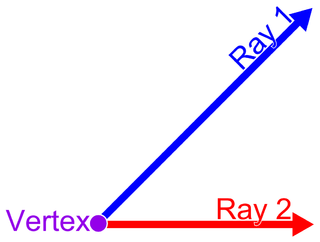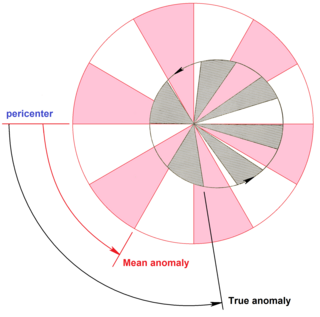
In plane geometry, an angle is the figure formed by two rays, called the sides of the angle, sharing a common endpoint, called the vertex of the angle. Angles formed by two rays lie in a plane, but this plane does not have to be a Euclidean plane. Angles are also formed by the intersection of two planes in Euclidean and other spaces. These are called dihedral angles. Angles formed by the intersection of two curves in a plane are defined as the angle determined by the tangent rays at the point of intersection. Similar statements hold in space, for example, the spherical angle formed by two great circles on a sphere is the dihedral angle between the planes determined by the great circles.
Frequency is the number of occurrences of a repeating event per unit of time. It is also referred to as temporal frequency, which emphasizes the contrast to spatial frequency and angular frequency. The period is the duration of time of one cycle in a repeating event, so the period is the reciprocal of the frequency. For example: if a newborn baby's heart beats at a frequency of 120 times a minute, its period—the time interval between beats—is half a second. Frequency is an important parameter used in science and engineering to specify the rate of oscillatory and vibratory phenomena, such as mechanical vibrations, audio signals (sound), radio waves, and light.

The radian is the SI unit for measuring angles, and is the standard unit of angular measure used in many areas of mathematics. The length of an arc of a unit circle is numerically equal to the measurement in radians of the angle that it subtends; one radian is just under 57.3 degrees. The unit was formerly an SI supplementary unit, but this category was abolished in 1995 and the radian is now considered an SI derived unit.
SI derived units are units of measurement derived from the seven base units specified by the International System of Units (SI). They are either dimensionless or can be expressed as a product of one or more of the base units, possibly scaled by an appropriate power of exponentiation.

The steradian or square radian is the SI unit of solid angle. It is used in three-dimensional geometry, and is analogous to the radian, which quantifies planar angles. Whereas an angle in radians, projected onto a circle, gives a length on the circumference, a solid angle in steradians, projected onto a sphere, gives an area on the surface. The name is derived from the Greek στερεός stereos 'solid' + radian.
In photography and cinematography, a normal lens is a lens that reproduces a field of view that appears "natural" to a human observer. In contrast, depth compression and expansion with shorter or longer focal lengths introduces noticeable, and sometimes disturbing, distortion.

In physics, angular frequencyω is a scalar measure of rotation rate. It refers to the angular displacement per unit time or the rate of change of the phase of a sinusoidal waveform, or as the rate of change of the argument of the sine function.

Bookworm is a general name for any insect that is said to bore through books. Contrary to their name, bookworms are not actually worms, but various types of insects including beetles, moths and cockroachs. The name bookworm comes from the many differant types of beetle who bore into books during their larval stage. These larvae may appear to the untrained eye to be worms.
Rotational speed of an object rotating around an axis is the number of turns of the object divided by time, specified as revolutions per minute (rpm), cycles per second (cps), radians per second (rad/s), etc..

A turn is a unit of plane angle measurement equal to 2π radians, 360 degrees or 400 gradians. A turn is also referred to as a cycle, revolution, complete rotation or full circle.

In celestial mechanics, the mean anomaly is the fraction of an elliptical orbit's period that has elapsed since the orbiting body passed periapsis, expressed as an angle which can be used in calculating the position of that body in the classical two-body problem. It is the angular distance from the pericenter which a fictitious body would have if it moved in a circular orbit, with constant speed, in the same orbital period as the actual body in its elliptical orbit.

A degree, usually denoted by °, is a measurement of a plane angle, defined so that a full rotation is 360 degrees.

A circular sector or circle sector, is the portion of a disk enclosed by two radii and an arc, where the smaller area is known as the minor sector and the larger being the major sector. In the diagram, θ is the central angle in radians, the radius of the circle, and is the arc length of the minor sector.

Radian Group Inc. provides private mortgage insurance, risk management products and real estate services to financial institutions.

Christian Cord codenamed Radian and later Phaser is a fictional mutant character in the Marvel Comics Universe. His first appearance was in New X-Men #135, created by Grant Morrison and Frank Quitely.

Micromyrtus is a genus of shrubs, in the family Myrtaceae, described as a genus in 1865. The entire genus is endemic to Australia.

Vincent Stewart, codenamed Redneck and later Skybolt is a fictional mutant character in the Marvel Comics Universe.
Micromyrtus chrysodema is a plant species of the Myrtaceae family endemic to Western Australia.














